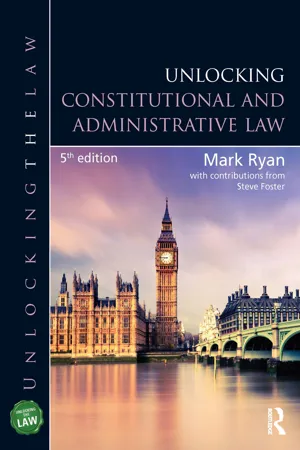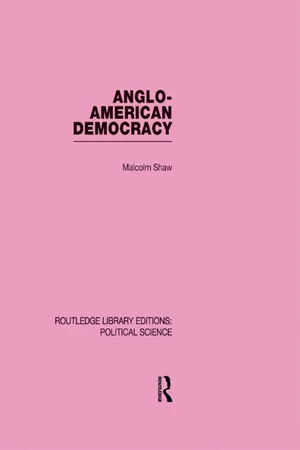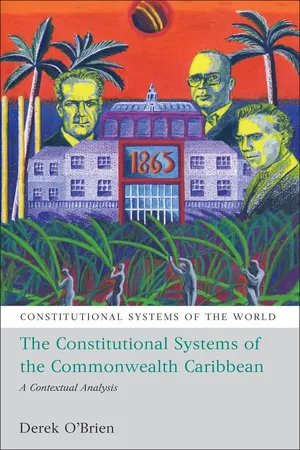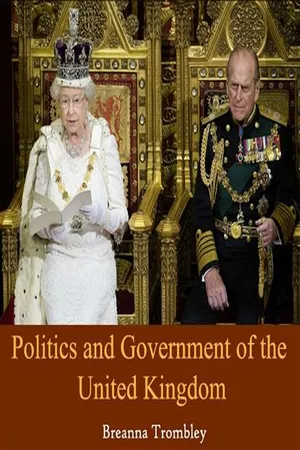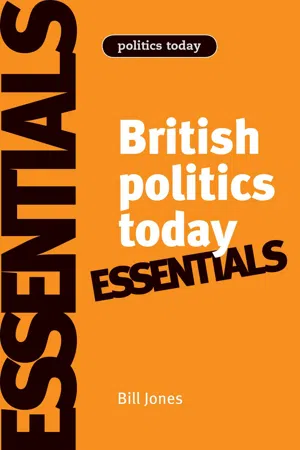Politics & International Relations
Executive Government UK
The executive government in the UK refers to the branch of government responsible for implementing and enforcing laws. It is headed by the Prime Minister and includes the Cabinet and various government departments. The executive government is responsible for making key decisions, formulating policies, and managing the day-to-day administration of the country.
Written by Perlego with AI-assistance
Related key terms
1 of 5
5 Key excerpts on "Executive Government UK"
- eBook - ePub
- Mark Ryan, Steve Foster(Authors)
- 2023(Publication Date)
- Routledge(Publisher)
- Government ministers.
- Central government departments.
- Executive agencies.
- Non-departmental public bodies.
- Non-ministerial departments.
- Local authorities.
- Devolved executive institutions.
ACTIVITY Quick quiz What do the following terms mean?- The Crown.
- The government.
- The executive.
11.2 The political executive/Her Majesty’s Government
11.2.1 The monarch
The political executive is constitutionally Her Majesty’s Government and ministers swear an oath of allegiance to the Crown. In practice, the monarch’s role is largely formal.On the monarchy, see A Hameed, ‘The monarchy and politics’ [2016] PL 401 and R Hazell and B Morris, The Queen at 90: The Changing Role of the Monarchy, and Future Challenges (The Constitution Unit, 2016).11.2.2 The Prime Minister
Although the monarch is the head of state and titular head of the executive, the Prime Minister is the effective head of government (contrast this with the position in the United States, where the elected President is both head of state and head of government). The constitutional office of the Prime Minister has developed historically by constitutional convention (contrast this with most other Prime Ministers/Presidents who owe their creation to a codified constitutional document) and is the head of the Cabinet (primus inter pares - Malcolm Shaw(Author)
- 2013(Publication Date)
- Routledge(Publisher)
7
Executives
The executive branch of government can be examined at four different levels. There is, first, the titular head of the state. Second, there is the chief executive. Third, there are the heads of departments. Fourth, there are the civil servants. Let us compare the working of the British and American executive at each of these levels.Heads of state
In British government the ceremonial and political roles are separated. The Queen is the ceremonial or titular head of the state while the Prime Minister is the chief executive or political head of the government. In the United States there is no such separation. The President is both the head of the state and the head of the government. The fact that the two roles are separated in Britain has an important effect on the style of politics and on the office of Prime Minister. The fact that they are not separated in America affects American political style and the office of President.Since the issue was finally and formally settled in 1689, the British Monarch has been subordinate to the Cabinet and to Parliament. Royal influence was politically significant at various times after 1689, but in our own time it can be assumed that British monarchs have no independent political power. Some constitutional authorities maintain that there are circumstances in which a Monarch would be justified in refusing a Prime Minister’s request to dissolve Parliament or in exercising personal discretion in other ways. But such an occasion, if it were to occur, would involve the monarchy in political controversy, and it is unlikely that a Sovereign would put the monarchy in jeopardy in such a way.The Prime Minister must confer with the Monarch regularly, and a Monarch who has been diligent in his or her attention to public affairs may have useful advice. But it need not be accepted. There is, too, the matter of choosing a new Prime Minister. However, as a consequence of the two-party system there is normally only one possible appointee. Even if there should be no obvious choice, the Monarch acts on advice and must in any event designate someone who is acceptable to the House of Commons.- eBook - PDF
The Constitutional Systems of the Commonwealth Caribbean
A Contextual Analysis
- Derek O'Brien(Author)
- 2014(Publication Date)
- Hart Publishing(Publisher)
4 The Executive Introduction – The Prime Minister and the Cabinet – The Public Service – Conclusion PART I: INTRODUCTION T HE CABINET SYSTEM of government, which provides for the government to be drawn from and accountable to the legislature, was introduced into the Commonwealth Caribbean somewhat belatedly by the Colonial Office in the years following the Second World War, as the apparatus of ‘Crown Colony rule’ was gradually dismantled and the region prepared for independence. Unsurprisingly, having fought so long to attain it, this was the system favoured by the region’s political leaders for their newly independent countries and was, accordingly, enshrined in all the Independence Constitutions. Each thus incorporated, either expressly or by implica-tion, the unwritten conventions that underpinned the operation of the Cabinet system of government as it had been evolving in Britain since the mid-nineteenth century. Under the Cabinet system executive authority is vested in the head of state, while executive power is vested in the Cabinet, comprising the Prime Minister and such other ministers from among the members of the legislature as the Prime Minister selects. The Cabinet is the principal instrument of policy and it is the Cabinet that is, collectively , charged with the general direction and control of government: deciding issues of policy, both domestic and foreign, and how public money should and should not be spent. Since independence, only one country in the region has departed from this template and that is Guyana, which in 1980 abandoned the tra-ditional Cabinet system in favour of an executive presidency, though it has more recently reverted to a semi-presidential system of government. 102 The Executive In this chapter I will begin by outlining the constitutional framework within which Cabinet government functions for all countries in the region, with the exception of Guyana, which I will deal with separately. - No longer available |Learn more
- (Author)
- 2014(Publication Date)
- Learning Press(Publisher)
As such, the incumbent wields both legi-slative and executive powers. In the House of Commons, the Prime Minister guides the law-making process with the goal of enacting the legislative agenda of the political party he leads. In his executive capacity, the Prime Minister appoints (and may dismiss) all other cabinet members and ministers, and co-ordinates the policies and activities of all government departments, and the staff of the Civil Service. He acts as the public face and voice of Her Majesty's Government, both at home and abroad. Solely upon the advice of the Prime Minister, the Sovereign exercises many of her statutory and prerogative powers: they include the dissolution of Parliament; high judicial, political, official and Church of England ecclesiastical appointments; and the conferral of peerages, knighthoods, decorations and other honours. Position The position of Prime Minister was not created; it has evolved slowly and erratically over three hundred years. Its origins are found in constitutional changes that occurred during the Revolutionary Settlement (1688–1720) and the resulting shift of political power from the Sovereign to Parliament. Early Prime Ministers (1720–1784) were at best ambivalent about that description; many refused to acknowledge or use the title. The position was given little formal recognition and was not mentioned in legal documents. Between 1784 and 1911, numerous accidents of history and political developments led to unofficial but popular acceptance of the office. By the 1830s, the Prime Minister became first among equals in the Cabinet and Head of Her Majesty's Government. By the turn of the 20th century, the modern Premiership had emerged; it had become the pre-eminent position in the constitutional hierarchy vis-a-vis the Sovereign, Parliament and Cabinet. - eBook - ePub
British politics today: Essentials
6th Edition
- Bill Jones, Dennis Kavanagh(Authors)
- 2013(Publication Date)
- Manchester University Press(Publisher)
Figure 13.1 ). (Most have been detailed earlier in this chapter.)Figure 13.1 The wiring of the core executiveSource: Michael Moran, Politics and Governance in the UK (Palgrave Macmillan, 2005), p. 118, figure 7.1 .• Prime Minister’s Office and related units – the Prime Minister’s Parliamentary Private Secretary, Chief of Staff, foreign policy adviser, EU adviser, Forward Strategy Unit, Director of Communications and Strategy, Office of Public Service Reform, Delivery Unit. Prime Ministers regularly tweak this machinery, creating and merging units as the need arises.• Cabinet. • Cabinet Office. • Cabinet Secretary. • Cabinet committees.• Departmental heads. The permanent secretaries of government departments are also included in the network called the core executive; they will spend much of their time within their departments but will be drawn into the ‘core’ from time to time according to the topic and the unfolding of events.How is the core executive’s policy presented?
Presentation is an essential part of government; some critics of Tony Blair argued that he saw it as most, sometimes all of government, rather than a mere aspect. We can judge only on the basis of what we know and how we come to know things about politics is therefore a contested area, sometimes bitterly so.Regular briefings
Government has an obvious interest in signalling its thoughts to the public on a very regular basis. Consequently, briefing is more or less continuous. Teams of media specialists (partisan experts or ‘spin doctors’) now organise this aspect of government activity, which had formerly been done by government information officers. The personnel within the core executive associated with directing press relations have tended to have a relatively high profile, especially Thatcher’s press secretary, Bernard Ingham, then Labour’s Communication Director Peter Mandelson and finally the most powerful of them all, Alastair Campbell, Tony Blair’s media chief and highly influential guru (often called ironically the ‘Deputy PM’). Briefings used to be secretive and ‘off the record’ but are now more open and attributable, with the Prime Minister holding a monthly press conference and agreeing to be questioned by a committee comprising the chairs of all the select committees.
Index pages curate the most relevant extracts from our library of academic textbooks. They’ve been created using an in-house natural language model (NLM), each adding context and meaning to key research topics.
